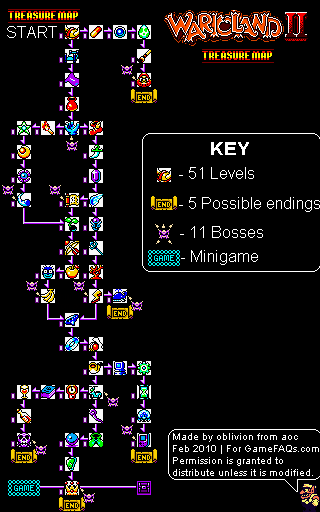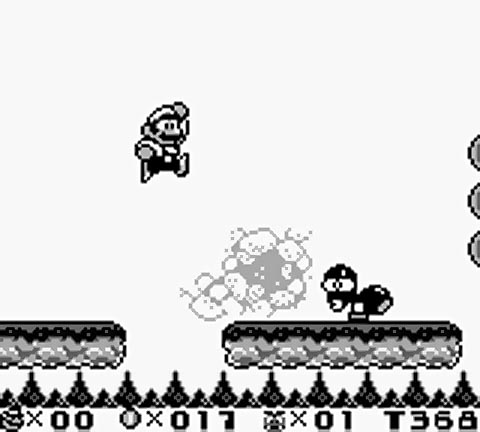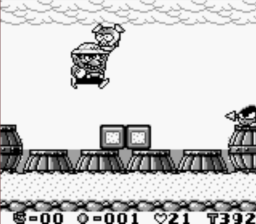Wario is an interesting character--in a lot of ways, he's more interesting than Mario is. Of course, there's a reason for that; Mario is essentially a static character, and if there's a point him, it's exactly that he is a static character. Almost as much as the taciturn ubermale of the FPS genre, his role is to be the constant that anchors his Nintendo series together, and lets the tangential spin-offs stay nominally connected as well. It's fitting, then, that a character whose starting definition is "Mario's Opposite" has, in contrast, at least, a character arc and evolving history. (Alternate version: I'm overthinking this, and the variety of game types Wario's tried his hands at pales before the career of Mario, who's been everything from a boxing referee to a spelling bee coach.)
Unfortunately, I'm not the person to relate that history. I just don't have enough experience with the Warioware series to talk about them in detail. That's the basic progression of Wario's arc--he starts as the protagonist of a series of platform side-scroller games designed as deviations from Mario games that are still somehow recognizeable as being Mario games to being a money-making schemer with an assortment of weird and motley hanger-ons as narrative- and character-based justifications for Nintendo to sell a bunch of loosely similar Flash-inspired games. And there's something worth saying to be said there as well, as I'd argue Warioware is a predecessor of sorts to Rusty's Real Deal Baseball, both being Nintendo's attempts to play with alternate game models without entirely abandoning their own approach and style.
But again, that's not what we're here to talk about. We're talking about Warioland II, and Wario's platforming days. Wario first appeared as the villain for Super Mario Land II: Six Golden Coins for the Gameboy, and that's a game I've got a lot of fondness towards. As a kid, I was terrible at videogames; my younger brother was far better at them, and the epitome of embarrassment for a ten year old is having to admit that your seven year old sibling is better than you in any way, shape, or form. But Super Mario Land II was different--its secret levels, its world map (which is derivative of Super Mario World, but as someone who never got to play it on the SNES, I didn't fully know that) and its forgiving nature (compared to Super Mario Bros 3)--it clicked with me, and I wound up thinking very kindly of it, and even of its vicious antagonist.
In short, I liked Wario, but with a pre-teen's funds being limited paltry things, my wages went to my main videogame genre of choice, the RPG, and I never got around to playing any of the Warioland spin-offs, not until decades later when I started becoming acquainted with the 3DS Virtual Store. A year or so back now, I bought myself Warioland: Super Mario Land III, and played through it. In some ways, it's a bit disappointing to play it in the context of Super Mario Land II, as the latter is much more of an open world thing, allowing you to play any of its six worlds in any order; Warioland kept the open world, but made it more linear.
Here they are side by side:
While both are vaguely shaped in a hub and spokes type design, the Warioland map is one way, with some secret offshoots. I can't really blame them--I imagine it makes level design easier to have a firm escalation as opposed to six roughly equivalent areas--but it does seem a little more "on the rails" in terms of exploration.
Anyway, a more interesting question is how the two games differ on a platform level. World maps are nice, but ultimately, 2-D Mario adventure games tend to come down to jumping and moving to the right and whatnot. And without going into a blow-by-blow of Warioland's design (we are, after all, ostensively here for Warioland II), the difference between it and Marioland II is immediately apparent. First, Wario is just *bigger* than Mario:
In effect, it doesn't come out to being much different in terms of pixel space, but by just filling out his space a little more, Wario seems much more brutish and bulky than Mario. This sense extends to his move set as well. Mario's relative vulnerability is a truism of the series; if he walks into a Goomba, it's Mario who gets hurt. If Wario walks into an equivalent opponent (and one not armed with, say a spear or something), it's the opponent that gets hurt. And that's a big difference. All through Warioland, I kept having to remind myself that I could knock enemies over by walking into them; I had to keep reminding myself that the option was there. Beyond the leisurely walk to victory, Wario's main attack is a charge into opponents and enemies, and his secondary move (not counting his own power-ups) is lifting up an enemy he's knocked over to toss it at something else. He's physically aggressive in a way Mario isn't (and it's a testament to Nintendo that Wario seems less aggressive even though Mario is the one whose first major power-up is consuming a flower and setting his enemies on fire).
The differences continue, in resources and plot. While coins are a sideline for Mario and mainly there for a way to gain lives, for the greedy, lucre-starved Wario, they're the point of the whole thing--Wario has to pay a nominal fee to use a checkpoint, and one to finish a level, a game over is particularly harsh because it means losing a treasure or all your coins, and at the end of the game, the ending is determined by how much money Wario has accumulated. Mario, more often than not, is adventuring to save a princess (a notable exception is Super Mario Land II, which happens because Wario steals Mario's castle from him). Wario, in perhaps my favorite twist, fights against a pirate princess, to steal her money. (It's never stated outright that Captain Syrup is a pirate princess, just a pirate, but I feel comfortable giving her a rank of pirate nobility.) I won't go so far to say that it's a feminist statement because, uh, it feels like a misstep to call Wario a feminist, but it's nice to see a subversion of sorts of the tired rescue cliche. In short, Warioland is just close enough to being a Mario game that it manages to constantly make you think of Mario in all the ways Warioland deviates from it.
Finally, then, let's turn to Warioland II.
Warioland II takes Warioland's deviations, and doubles down. Perhaps the biggest one is that it removes two Super Mario 2-D staples: the countdown clock and the multiple lives. Wario is, in effect, immortal; rather than ever die from enemy assaults, he is only pushed back and loses a few coins. And in boss fights, it's just pushed back--though in those cases, he's thrown off the screen and has to fight the boss again from the beginning. And to be fair, that's a fairly stiff penalty for some of the later bosses, who take a half dozen well-timed hits to defeat. I think I would have still been able to complete the game without using the Gameboy Advance emulator's save state feature, but it would have been a lot more frustrating.
Years, ago, in a discussion of the death mechanics of Dark Souls, Yahtzee Croshaw argued that there were two main ways of punishing a player with death in videogames. One approach is to return you exactly to where you where, and the other returns to the player to a past point, making her fight for every inch of progress. The former preserves flow, and the latter maintains challenge. While I don't necessarily agree with everything he says there--especially his hard line that good design can only one or the other--it's a useful starting point for thinking about what happens in Warioland II when the clock and the lives are taken out of the equation. In this case, a lives counter and a timer place the emphasis on performance. In order to succeed, you need to demonstrate a certain consistent level of ability, even if it's "don't get hit too often" and "move fast enough to beat the clock." Removing them shifts the focus to the game's real center: collecting money and exploration.
Once again, the plot and goals of the game center around Wario accumulating lucre. Here, though, the process is slightly inverted, as rather than stealing the money from Syrup, she's stolen it from Wario, and the game is about recovering it, the minimalist story told through a series of cutscenes. Warioland II also goes one step further in its streamlining, as the world map is gone entirely. In its place, you get an area chart, but it's only available at the end of the game. Rather than finding a lot of passages that lead to secret levels, there's a few of them that lead to a bunch of connected levels; exploring them feels a little like exploring alternate timelines.
 |
| The level map for Warioland II |
The game plays more or less the same as Warioland, which means it too walks that line between not being a Mario game yet still similar enough to one that you're constantly thinking about them. If I wanted to be academic about it, I'd say it's the videogame equivalent of the uncanny, creating an experience that is similar to Mario games but just different enough to seem unsettling. There is, however, one significant difference between play in Warioland and Warioland II. In Warioland, there were various power-up helmets that gave Wario powers: bull horns, dragon head, rocket pack. Here, instead, there are enemies that alter Wario's state. A bat with a sledge, for example, flattens Wario, making him shorter, and allowing him to float. A fox with a fire pipe (or something) sets him ablaze, which makes him continually move in a single direction (only changing when running into something) but also capable of smashing fire blocks. The effects are usually temporary, always reversible, and never last longer than the level at hand. The consequence of this change is that it once again shifts focus from performance to exploration. In regular Mario games, you attempt to keep, say, a fire-powered Mario or a Raccoon Mario in levels that don't necessarily contain either as a way of gaining advantage. Here, altered Wario states are not about maintaining some sort of advantage over enemies, but solving a puzzle that's been placed before you.
The levels are standard side-scroller fare--you generally move from left to right, and each handful of levels is thematically the same, leading up to a miniboss. Chapter one (and the first branching secret chapter, chapter two) are all themed around Wario's giant castle, and so you spend a lot of time playing with the drainage system and so forth. The chapter that follows one if you don't go the secret route is also called chapter two, so the level naming tends to get complicated quickly, so we'll just abandon the whole thing. The main quest line has you going through a series of levels on a boat, a train, through the maze woods, through an urban city (!), and through Syrup's castle. The alt secret levels have you going through a cave, a subterranean Aztec city (also !, though a little more expected in the fantastic milieu), a factory (which leads to one of the harder final bosses), and a haunted house. It's all standard stuff, though the more industrialized/urban settings make it feel appropriately non-Mario. (Donkey Kong Country does something similar.)
Plus,this the boss of the city levels is a b-ball playing rabbit. So that happens.
 |
| I'm guessing there's a designer who was fond of Space Jam. |
While the accumulation of gold was the whole point of Warioland, in Warioland II, it's more a means to an end. In addition to completion or the discovery of secret routes, each level of the game has two other lucre-based subgoals. Somewhere in every level, there's a room that leads to a matching mini-game, where you have to find the match for a given card depicting a generic enemy type among eight cards. 50 coins buys you a brief look; 100 a medium look, and 200 a lasting look. And if you make the match, you get a treasure, which nets you a small cash amount (I never bothered to learn the exact amount, which is admittedly lazy) and notes on the level map that the treasure has been found. And at the end of the level, there's another game, where you pay money to reveal parts of a card depicting a number from 0 to 9, at 50 g for a subdivision. If you guess the number correctly, you then get a piece of a treasure map. And if you collect ALL the pieces--that's one from every level--then you get access to a secret bonus level. More on the level in a moment, but it's worth noting that this suggests that exploration is valued above wealth, since the latter is a means for encouraging the former; the only problem with that thesis is that the cutscene rewards for full exploration are always Wario getting away with a sack of money (sometimes, a literal sack, with a dollar sign on it. Wario is a fan of the classics).
Remember how Warioland II is about exploration and taking your time over performance? Well, the bonus level is the exception to that. While it doesn't have timer-related death, it does introduce a timer, and, appropriately, it demands an excruciating level of skill above and beyond anything required in the rest of the game. I'll spare you all the details, but include a few highlights that had me spamming the save state (video credit to ):
First, there was this bit where I had to ferry a monster through narrow tunnels to throw it at a set of monster blocks:
Then there was a section where you have to cross a platform that is only solid for enemies, by repeatedly jumping on one, pushing it to the right and using it to jump over the gap:
And then there's a bit with about a dozen vertical jumps with no margin for errors:
Next is a bit that combines two of the others, where you have to use flying enemies to make vertical jumps:

I got to the spear holder, but after a few dozen attempts, I admitted that, baring sheer luck, the number of ground pounds needed will always allude me. There but the grace of a final money-bag-holding cutscene go I. (Also, I feel it has to be said: damn, this level is creepy. The eyes, ears, and mouths inserted into the background are weird, especially the mouths that are spewing water.)
And finally, there's the boss of the area, a giant spear holder standing on an enemies-only platform, which means you have to perform twelve consecutive ground pounds to defeat him, all in one go.

I got to the spear holder, but after a few dozen attempts, I admitted that, baring sheer luck, the number of ground pounds needed will always allude me. There but the grace of a final money-bag-holding cutscene go I. (Also, I feel it has to be said: damn, this level is creepy. The eyes, ears, and mouths inserted into the background are weird, especially the mouths that are spewing water.)
It's an interesting design for an interesting game. Rather than focus on performance and defeating enemies throughout, Warioland II pushes the platform adventure more towards the puzzle and exploration side, de-emphasizing the agon of fending off enemies. Even in this special level where performance is more demanding than anywhere else in the game, the demand of fighting the enemies is virtually nil in comparison to mastering the techniques needed to navigate the area's puzzles. In the first game, Wario was defined largely by his greater propensity for physical violence than Mario. By removing the threat and longer term consequences of minor enemies, Warioland II shifts the focus away from action towards puzzle, while still letting the game feel like the first. Exactly what Wario means as a character is a hard thing to pin down--what does antihero even mean in a genre typified by platform jumping? Eventually, Nintendo will sidestep the question by turning him less into Mario's strange double and more into his own weird self with the Warioware series; here, Warioland II offers a way to expand on the original without losing entirely what made it interesting to begin with.
Later Days.
Later Days.












No comments:
Post a Comment